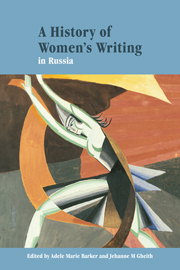Book contents
- Frontmatter
- Contents
- Notes on contributors
- Acknowledgments
- Note on transliteration
- List of abbreviations
- Introduction
- 1 Women's image in Russian medieval literature
- 2 Sappho, Corinna, and Niobe: genres and personae in Russian women's writing, 1760–1820
- 3 The inexperienced muse: Russian women and poetry in the first half of the nineteenth century
- 4 Women of the 1830s and 1850s: alternative periodizations
- 5 “A particle of our soul”: prerevolutionary autobiography by Russian women writers
- 6 The women of Russian Montparnasse (Paris, 1920–1940)
- 7 Women in Russian Symbolism: beyond the algebra of love
- 8 The eastern path of exile: Russian women's writing in China
- 9 Realist prose writers, 1881–1929
- 10 Women and gender in post-symbolist poetry and the Stalin era
- 11 Writing the female body politic (1945–1985)
- 12 In their own words? Soviet women writers and the search for self
- 13 Women's poetry since the sixties
- 14 The persistence of memory: women's prose since the sixties
- 15 Perestroika and post-soviet prose: from dazzle to dispersal
- Bibliographical guide to writers and their works
- Guide to further reading
- Index
9 - Realist prose writers, 1881–1929
Published online by Cambridge University Press: 22 September 2009
- Frontmatter
- Contents
- Notes on contributors
- Acknowledgments
- Note on transliteration
- List of abbreviations
- Introduction
- 1 Women's image in Russian medieval literature
- 2 Sappho, Corinna, and Niobe: genres and personae in Russian women's writing, 1760–1820
- 3 The inexperienced muse: Russian women and poetry in the first half of the nineteenth century
- 4 Women of the 1830s and 1850s: alternative periodizations
- 5 “A particle of our soul”: prerevolutionary autobiography by Russian women writers
- 6 The women of Russian Montparnasse (Paris, 1920–1940)
- 7 Women in Russian Symbolism: beyond the algebra of love
- 8 The eastern path of exile: Russian women's writing in China
- 9 Realist prose writers, 1881–1929
- 10 Women and gender in post-symbolist poetry and the Stalin era
- 11 Writing the female body politic (1945–1985)
- 12 In their own words? Soviet women writers and the search for self
- 13 Women's poetry since the sixties
- 14 The persistence of memory: women's prose since the sixties
- 15 Perestroika and post-soviet prose: from dazzle to dispersal
- Bibliographical guide to writers and their works
- Guide to further reading
- Index
Summary
By the end of the nineteenth century, the number of women prose writers in Russia had increased to an unprecedented level. The critic V. Chuiko stated in 1889, “There have never been so many women in Russian literature as now. A woman writer with a reputation, a woman who translates or writes for a newspaper is far from being a rare phenomenon in Russian society.” By 1899 the critic A. Skabichevskii further emphasized the significant increase in the number of women writing prose, claiming that Russia was being “inundated” by women's prose fiction, and that almost as many female prose writers as male were being published in the “thick journals.”
This chapter can deal with only a small number of the numerous texts by women realist prose writers who rose to prominence during the period 1889—1929. Although some reference will be made to writers' differing stylistic techniques, the main focus will be on the themes of women's prose that (with the possible exception of works by accomplished stylists such as Ol'nem and Teffi) constitute its main interest and originality. “Realist” and “feminist” writing will be treated separately, although it is difficult to draw any clear distinction between them, since women realists, while providing general insights into contemporary society, are often particularly successful at depicting female characters and raising issues of interest to women.
- Type
- Chapter
- Information
- A History of Women's Writing in Russia , pp. 175 - 206Publisher: Cambridge University PressPrint publication year: 2002
- 1
- Cited by

